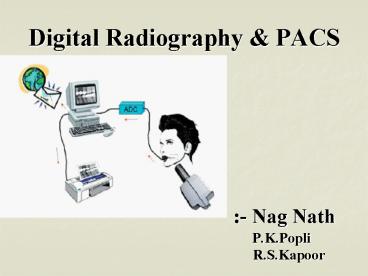Digital Radiography - PowerPoint PPT Presentation
1 / 13
Title:
Digital Radiography
Description:
Wide latitude of CCD. Increased tube life* Cost savings:- Elimination of films. ... Hard copy image have fixed gray scale and relatively limited dynamic range. ... – PowerPoint PPT presentation
Number of Views:96
Avg rating:3.0/5.0
Title: Digital Radiography
1
Digital Radiography PACS
- - Nag Nath
-
P.K.Popli -
R.S.Kapoor
2
The Advantages-
- Minimal Space demand.
- Reduces radiation dose.
- Facility of post-processing.
- Simultaneous availability of image.
- Cost savings.
- Enhanced teaching and research opportunity.
3
How can it reduce radiation dose ?
- Decreased rate of repeat. (post processing)
- Wide latitude of CCD.
- Increased tube life
4
Cost savings-
- Elimination of films.
- Elimination of chemical and processors.
- Reduction in maintenance cost.
- Less requirement of staff.
- Reduction in space.
5
Conventional film Vs CCD
6
Conventional film Vs CCD
7
Reporting on monitor, how reliable it is?
- Monitor luminance- 200 to 800 cd/m².
- View box luminance- 2000 cd/m².
- Hard copy image have fixed gray scale and
relatively limited dynamic range. - Monitor have the option of changing window and
level in real time and therefore getting access
to the higher contrast resolution.
8
Reporting on monitor, how reliable it is?
- The printed radiographic film is typically
associated with a pixel array of about
4,000 5,000 for a 35cm 43cm. - For monitor with 30cm 36cm size 2,500
3,000 pixel is sufficient and combined with a
regional zoom function provides a magnificent
appreciation of image.
9
Requirements fulfilled by PACS-
- Images must be acquired reliably and at high
speed. - System network must be able to handle the
heaviest anticipated work load. - Network must be expandable for recent
development. - Must follow DICOM standards.
10
Components installed in PACS-
- RAID (redundant arrays of inexpensive discs) and
RAID server. - Deep archive and deep archive server.
- Patient data base server.
- Work list generator.
- RIS interface.
- Image distribution cluster server.
11
Challenges-
- Initial high equipment cost.
- Massive data storage requirements of radiographic
images. - Physician radiologist reluctance to interpret
from monitor. - Staff resistance.
- Security.
- System crash.
12
Manipulation display
Imaging device
Voice
Work station
RIS
HIS
- Data base management system
Non local communication
Long term archive
Hard copy
Remote
Tele radiology
13
Why India needs it-
- Lower cost.
- Less time per patient.
- High through put.
- Better environment for medical research.
- A step ahead towards globalization.
- Future compulsion.
14
Thank you.



























![[PDF] Radiography in Veterinary Technology 4th Edition Kindle PowerPoint PPT Presentation](https://s3.amazonaws.com/images.powershow.com/10095121.th0.jpg?_=20240810014)
![[PDF] Radiography Essentials for Limited Practice 6th Edition Free PowerPoint PPT Presentation](https://s3.amazonaws.com/images.powershow.com/10095119.th0.jpg?_=20240810013)


